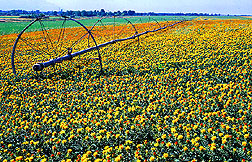This page has been archived and is being provided for reference purposes only. The page is no longer being updated, and therefore, links on the page may be invalid.
|
|
New Safflower Lines Survive Winters
By Jan SuszkiwMarch 25, 2008
Three new safflower germplasm lines developed by Agricultural Research Service (ARS) scientists in Pullman, Wash., are now available for improving the oilseed crop's winter survival, or "hardiness."
The germplasm lines—dubbed WSRC01, WSRC02 and WSRC03—owe their superior winter hardiness to three Chinese safflower accessions maintained at the ARS Plant Germplasm Introduction and Testing Research Unit in Pullman.
According to ARS agronomist Richard C. Johnson, winter-hardy safflower varieties derived from the three new germplasm lines should offer farmers a number of benefits. Among these are the option of fall plantings, winter ground cover, rotation with other crops like wheat, better weed control, improved water-use efficiency, and higher seed yields than spring-planted safflower crops.
Safflower is primarily grown for three products: oil, meal and birdseed. The oil is mainly used for cooking and in salad dressings and margarine. Safflower oil also is used in paint bases and can be converted into biodiesel. High-fiber, high-protein meal from crushed seeds is fed to livestock, while intact safflower seeds are marketed as birdseed. Dyes are made from the crop's flowers.
Winter hardiness, which has been lacking in existing varieties, could expand safflower use in the West and the Southern Great Plains, notes Johnson. WSRC01, 02 and 03 are adapted to many sites in these regions and mark the first U.S. safflower releases specifically for that trait.
During field trials in eastern Washington State, the three lines showed winter hardiness superior to cold-tolerant safflowers that were used as experimental controls for comparison. The new safflower lines grew to a height of nearly 3 feet, stood upright and produced red flowers. On average, the lines' seed contained 80 percent linoleic acid and 14 percent oleic fatty acid.
Johnson, who is handling seed requests, co-developed the safflower germplasm lines with fellow ARS agronomist Vicki Bradley. Professor Li Dajue at the Beijing Botanical Gardens in China also collaborated.
ARS is the U.S. Department of Agriculture's chief scientific research agency.


